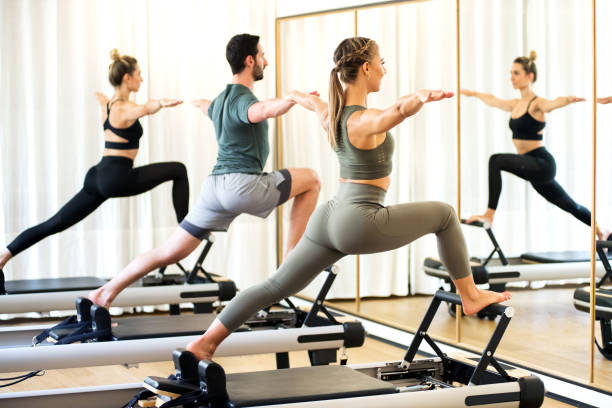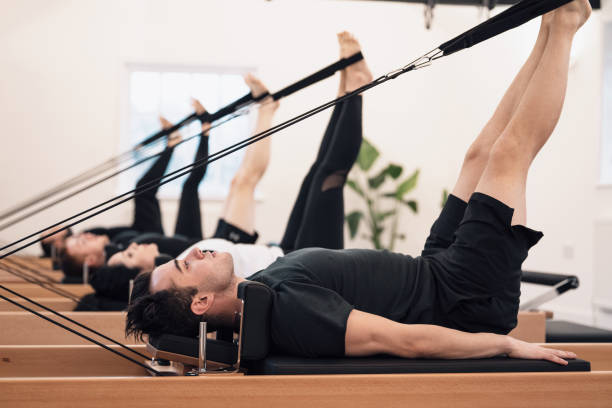Pilates is known for helping sculpt bodies, but it has much more to offer than a slimmer figure and better posture. This low-impact exercise builds a foundation of strong muscles, core strength, and body awareness.
A March 2018 study found that people who do Pilates improve their balance, mobility, and ability to control the body’s movements.

1. Strength
Pilates strengthens under-used muscles, improves balance and reduces the risk of injury. And though the exercises may feel gentle, it’s not a low-impact workout: Those who perform it regularly can expect to “whip up a sweat,” says Gale.
It also promotes stable and efficient body mechanics, which can help prevent injuries during more dynamic exercise—like running or weight-lifting. That’s because Diamond Creek pilates helps you recruit deeper stabilizer muscles, which support your spine and lumbopelvic area, and increases the flexibility of limb joints.
Their Pilates also teaches you to activate the core, or powerhouse, which comprises the abdominal muscles, lower back muscles, hips, inner thighs and pelvic floor. When these muscles are strong, they work like a corset to support the frame of your body and enhance posture. This can make a big difference between experiencing neck pain, shoulder or back problems or sitting, standing and walking tall with ease.
2. Flexibility
Pilates teaches you to move with greater control, precision and a full range of motion. It lays bare imbalances in movement that can lead to injury, and guides you in how to fix them. The movements may look simple, but they take a lot of thought to perform correctly. And if you do them well, they work together to create a flowing sequence that reminds you of a dance.
Unlike many other workouts, Pilates strengthens smaller muscle groups and the core — the muscles in your trunk. This helps you keep proper alignment throughout your day, which can help prevent back pain.
It also helps you get more out of dynamic exercises, such as distance running or high-intensity activities, by providing better kinetic chain mobility. That’s because Pilates builds strength through the core and lumbopelvic area, which helps stabilize and support more dynamic movements.

3. Stability
Pilates in Diamond Creek Shopping is known for promoting core strength and correcting poor posture. “The core consists of all the muscles surrounding your trunk that, when strong and pliable, allow you to move and support your body with greater ease,” explains Gale. Pilates exercises also focus on proper alignment to build stability and prevent injury.
Another stability benefit is that Pilates helps you learn how to engage and fire specific movement chains that may have been asleep for a long time, says Green. This, in turn, can improve your balance and posture and even reduce menstrual pain (think: Dysmenorrhea).
In addition to strengthening your muscles, a Pilates workout will help you develop length and flexibility, says Jordan. For example, performing an exercise called the roll-up — lying on your back with your legs extended toward the ceiling and reaching for your toes, a twisting motion in which you articulate your spine one vertebrae at a time — can strengthen your abs while improving your hamstring and spinal flexibility.
4. Endurance
Pilates movements may look simple, but they require a high degree of precision and control. This type of exercise can help you learn how to perform exercises for longer periods, which improves your kinaesthetic awareness and endurance.
Like other mindful movement workouts, such as yoga, tai chi and qigong, Pilates focuses on moving your body with purpose. This approach can lead to increased body awareness, which may be helpful for preventing injury or mishaps that could occur in your daily life (like tripping over a kid’s toy).
Another important benefit of Pilates is its ability to strengthen the muscles that support the spine, which helps improve posture. This, along with the core and abdominal muscle strength and balance gains, can make a big difference in how you feel day to day. This can mean a reduced risk of low back pain, headaches and neck tension (like those you might get from sitting all day at work) (2, 3). (3).
5. Balance
Pilates helps you achieve balance by improving posture and strengthing the core muscles that keep your body stable. Having balanced core muscles can help prevent injuries during everyday movements, like lifting objects or bending over to pick up something off the ground.
Aside from promoting healthy, strong muscles that support your joints, good balance also reduces pain and improves the quality of life. For instance, a study found that women who did Pilates had less dysmenorrhea (painful menstrual periods).
The control and precision emphasized in Pilates exercises is helpful for improving balance because it trains your muscles to move efficiently. This can help you avoid injuries that may result from bad habits in daily life, such as tripping over something or falling while walking down the stairs. The focus on breathing deeply can also encourage mindfulness and enhance the mind-body connection, which can be beneficial for reducing stress levels.
6. Self-awareness
Pilates’ emphasis on precision cultivates a heightened awareness of the body, including how muscle groups function. This mindfulness can carry over into daily life, enabling us to recognize and address imbalances, as well as improve emotional regulation.
During Pilates, breathing is coordinated with movement to enhance proprioception and amplify the mind-body connection. In doing so, Pilates can have a meditative effect that helps relieve anxiety and stress by stimulating serotonin production.
It also increases the ability to understand and accept that the body is different from class to class; maybe last week you held your plank for a minute, but today you can only hold it for 30 seconds. Developing this self-awareness can help you extend more grace to yourself in non-exercise situations, like if you miss a meeting or make a mistake at work. That’s what we call practicing self-compassion.